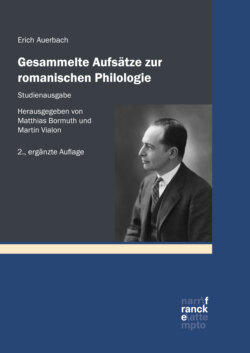Читать книгу Gesammelte Aufsätze zur romanischen Philologie – Studienausgabe - Erich Auerbach - Страница 15
I. Aquila volans ad escam
ОглавлениеWe begin with the prophetic dream Purg. 9, 13–33
Ne l’ora che comincia i tristi lai
la rondinella presso a la mattina,
forse a memoria de’ suoi primi guai,
e che la mente nostra, peregrina
più da la carne e men da’ pensier presa
a le sue vision quasi è divina,
in sogno mi parea veder sospesa
un’aguglia nel ciel con penne d’oro,
con l’ali aperte e a calar intesa;
ed esser mi parea là dove fuoro
abbandonati i suoi da Ganimede,
quando fu ratto al sommo consistoro.
Fra me pensava: ‘Forse questa fiede
pur qui per uso, e forse d’altro loco
disdegna di portarne suso in piede.’
Poi mi parea che, poi rotata un poco
terribil come folgor discendesse,
e mi rapisse suso infino al foco.
Ivi parea che ella e io ardesse …
The diving and the rising of the eagle recall not only Ganymede but also an old figurative tradition which occurs first, as far as I know, in Gregory the GreatGregor d. Große. It originates from the exposition, inspired by the PhysiologusPhysiologus, of the verse Job 9, 26 (sicut aquila volons ad escam) combined with other biblical passages (Job 29, 37; Is. 40, 31; Exod. 19, 4), and it is based upon the interpretationFiguraldeutung of the contrast between the soaring flight of the eagle towards the sun and his diving to earth. Moris quippe est aquilae, says Gregory in his commentary to Job,2 ut irreverberata acie radios solis aspiciat; sed cum refectionis indigentia urgetur, eandem oculorum aciem, quam radiis solis infixerat, ad respectum cadaveris inclinat; et quamvis ad alta evolet, pro sumendis carnibus terram petit. The most important and widespread interpretation of this contrast connects it with Christ’s divine nature, his incarnation and ascension: incarnatus dominus ima celeriter transvolans et mox summa repetens (Gregory on Job 39, 27; Patr. Lat., LXXVI, 625). There are variants: sometimes the eagle is conceived not as Christ, but as the faithful soul contemplating his incarnation and ascension. Anyway, the rerising is a separation from the flesh (peregrina più da la carne), and thus it is for the rapt soul the contemplative ecstasy which leads to the joining with Christ in the fervor of the unio mystica (ivi pareo che io e ella ardesse).3 That we have to deal with contemplative ecstasy could also have been proved by the figurative interpretationFiguraldeutung of the sleep,4 and the word ratto evokes for a typologically trained ear the rapture of St Paul, 2 Cor. 12, 4, which is one of the Leitmotifs of the Commedia.
In this way, DanteDante’s eagle would become here figurafigura Christi.5 This does not imply that other interpretations are necessarily false. The principle of ‘polysemy’, which DanteDante claims for his poem in the Letter of CangrandeCangrande della Scala,6 had already been established for the figurative exposition of the Bible by AugustineAugustinus, De Doctrina Christiana 3, 25 et seq., and the later commentators almost always give for difficult passages several typological interpretationsFiguraldeutung, sometimes alternative, more often cumulative,7 on condition that they do not contradict the faith (sententia …, quae fidei rectae non refragatur, Augustine, loc. cit., 3, 27). Nor is it altogether certain that everything which applies to the eagle applies also to Lucia; I am inclined to think that the prophetic dream has a wider implication than Lucia’s intervention. At any rate the imperial-political meaning which is certainly present at least in the dream,8 is not touched by our exposition; nor have we dealt with the problem why the eagle of Jove seizes its prey only from Mount Ida. But now we will add some hints on this subject. Mount Ida, where Ganymede was stolen, is the divine mountain of Troy, the origin dell’alma Roma e di suo impero (Inf. 2, 20); it stands here for the valley of the princes on the slopes of the mountain of the Purgatorio, a place of diletto and bel soggiorno (Purg. 7, 45; 48; 63; 73 et seq.), covered with flowers like the earthly Paradise or Elysium; but it is also vallis lacrimarum, still subject to timores nocturni,9 where among the princes dwells Rudolf von HabsburgRudolf v. Habsburg, che più siede alto e fa sembiante d’aver negletto ciò che far dovea (Purg. 7, 91–92); both Mount Ida and the valley of the princes10 obviously represent the Saturnian age, peaceful, imperial, golden, but lost. And only from that place does the eagle take his prey to carry it towards the unio mystica! Corresponding to this is DanteDante’s mystical sleep in the earthly Paradise which immediately precedes the vision of the nova Beatrice (Purg. 32, 64 et seq.) explicitly connected with the vision in LukeLukas (Evangelist) 9, 28–36;11 corresponding to this above all is Jacob’s ladder which also signifies contemplation leading to the highest vision,12 and which rises from the heaven of Saturn, immediately after the following description:
… cristallo che ’l vocabol porta,
cerchiando il mondo, del suo caro duce,
sotto cui giacque ogni malizia morta. (Par. 21, 25–27)
